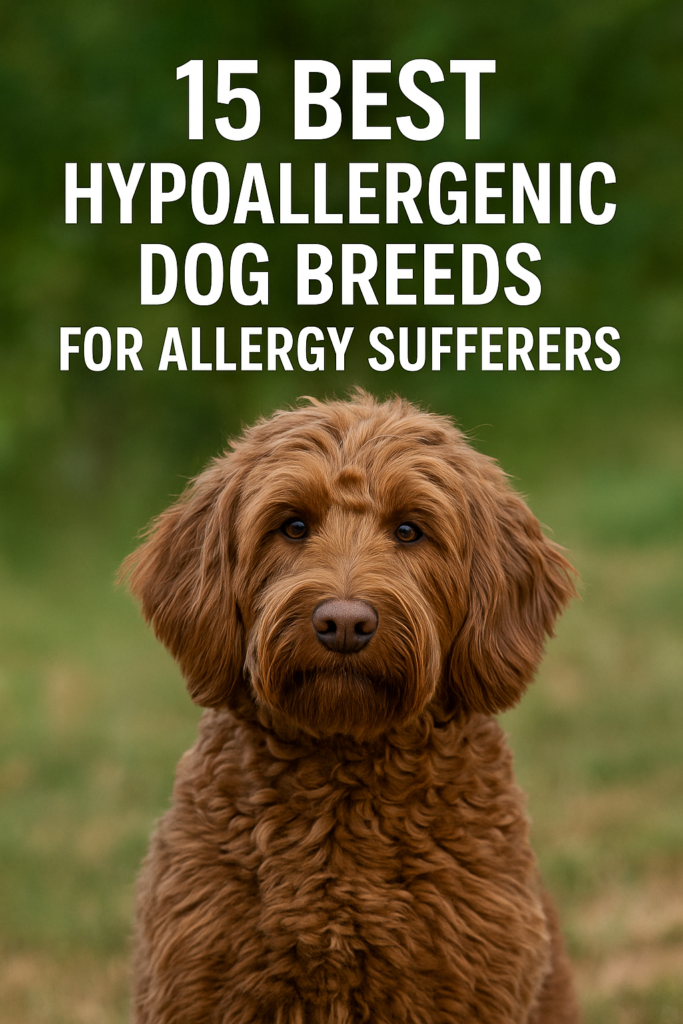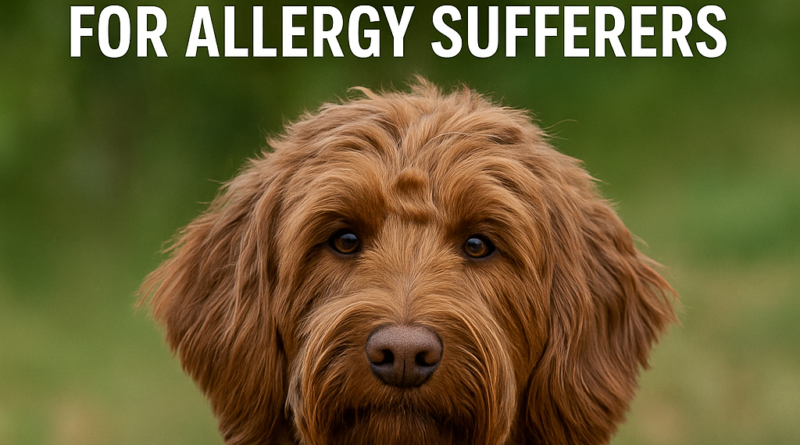15 Best Hypoallergenic Dog Breeds for Allergy Sufferers
For millions of people around the world, owning a dog is a dream. But for those who suffer from allergies, that dream can feel out of reach. The good news is, it’s not. While no dog is completely hypoallergenic, there are several breeds that produce fewer allergens than others. These breeds are often recommended for individuals who want the love and companionship of a dog without constant allergy flare-ups.
In this detailed guide, we’ll explain what makes a dog hypoallergenic, explore the causes of dog-related allergies, and introduce you to the best hypoallergenic dog breeds that may be suitable for you.

Understanding Hypoallergenic Dogs
What Does “Hypoallergenic” Mean?
The term “hypoallergenic” refers to something that is less likely to trigger an allergic reaction. In dogs, it means breeds that are less prone to shedding and typically produce lower amounts of dander, the primary source of allergens.
The Real Allergen: It’s Not Just the Hair
Many people mistakenly think it’s dog fur that causes allergic reactions. In reality, the problem is a protein found in a dog’s dander (dead skin), saliva, and urine. When dogs groom themselves or shed, these proteins can become airborne, making it easy for allergy sufferers to inhale them.
Causes of Dog Allergies
The main allergen involved in dog allergies is a protein known as Can f 1. This protein is found in a dog’s skin cells, saliva, and urine. When it dries, it becomes airborne and can be inhaled, leading to symptoms such as:
- Sneezing
- Nasal congestion
- Runny nose
- Coughing
- Itchy or watery eyes
- Skin irritation
- Asthma attacks in severe cases
Allergy symptoms can vary in intensity from person to person. For some, being in the same room with a shedding dog can cause discomfort, while others may only react after prolonged exposure.
Top 15 Hypoallergenic Dog Breeds (With Detailed Profiles)
1. Poodle (Toy, Miniature, Standard)
Allergy-Friendly Traits: Poodles have tight, curly coats that trap dander and prevent it from spreading.
Temperament: Intelligent, eager to please, highly trainable. Great with kids and other pets.
Size: Comes in three sizes — toy, miniature, and standard.
Exercise Needs: Moderate to high.
Lifespan: 12–15 years.
Grooming Tips: Regular professional grooming every 4–6 weeks and brushing at home help reduce allergen buildup.
2. Bichon Frise
Allergy-Friendly Traits: This breed has a double coat that catches dander.
Temperament: Cheerful, affectionate, loves human company.
Size: Small (weighs 10–18 pounds).
Exercise Needs: Moderate.
Lifespan: 14–15 years.
Grooming Tips: Requires brushing several times a week and regular haircuts.
3. Maltese
Allergy-Friendly Traits: Fine, silky hair that doesn’t shed much.
Temperament: Gentle, fearless, and lively.
Size: Tiny — typically under 7 pounds.
Exercise Needs: Low to moderate.
Lifespan: 12–15 years.
Grooming Tips: Daily brushing is ideal to prevent mats.
4. Portuguese Water Dog
Allergy-Friendly Traits: Water-resistant coat with low shedding.
Temperament: Loyal, athletic, and adventurous.
Size: Medium.
Exercise Needs: High — loves water and outdoor activities.
Lifespan: 11–14 years.
Grooming Tips: Brush weekly and trim coat every month.
READ ALSO: Top 10 Best Dog Breeds for First-Time Owners: A Beginner-Friendly Guide
5. Shih Tzu
Allergy-Friendly Traits: Hair grows like human hair, minimal shedding.
Temperament: Sweet, adaptable, and friendly.
Size: Small.
Exercise Needs: Moderate.
Lifespan: 10–16 years.
Grooming Tips: Needs daily brushing and regular grooming.
6. Labradoodle (Poodle + Labrador Mix)
Allergy-Friendly Traits: Inherits the Poodle’s low-shedding qualities (especially in F1B generations).
Temperament: Friendly, social, and often used as therapy dogs.
Size: Varies by generation — from medium to large.
Exercise Needs: High.
Lifespan: 12–14 years.
Grooming Tips: Brush 2–3 times a week and groom every 6–8 weeks.
7. Yorkshire Terrier (Yorkie)
Allergy-Friendly Traits: Fine, silky hair — sheds very little.
Temperament: Confident, bold, and affectionate.
Size: Toy breed.
Exercise Needs: Moderate.
Lifespan: 13–16 years.
Grooming Tips: Brush daily and trim regularly.
8. Soft-Coated Wheaten Terrier
Allergy-Friendly Traits: Single coat with low dander.
Temperament: Spirited, happy, and people-oriented.
Size: Medium.
Exercise Needs: High.
Lifespan: 12–14 years.
Grooming Tips: Needs brushing every few days.
9. Cairn Terrier
Allergy-Friendly Traits: Dense, wiry coat with minimal shedding.
Temperament: Curious, cheerful, and alert.
Size: Small.
Exercise Needs: Moderate.
Lifespan: 13–15 years.
Grooming Tips: Brush weekly and hand-strip coat seasonally.
10. Chinese Crested
Allergy-Friendly Traits: Nearly hairless, minimal dander.
Temperament: Playful, affectionate, and entertaining.
Size: Small.
Exercise Needs: Low.
Lifespan: 13–18 years.
Grooming Tips: Regular bathing and skincare essential to avoid dryness.
11. Basenji
Allergy-Friendly Traits: Very low shedding and no “doggy” smell.
Temperament: Independent and reserved but loyal.
Size: Small to medium.
Exercise Needs: High.
Lifespan: 12–14 years.
Grooming Tips: Occasional brushing is enough.
12. Havanese
Allergy-Friendly Traits: Soft coat that holds dander.
Temperament: Gentle, outgoing, and loyal.
Size: Small.
Exercise Needs: Moderate.
Lifespan: 14–16 years.
Grooming Tips: Brush several times a week.
13. Afghan Hound
Allergy-Friendly Traits: Low dander and minimal shedding.
Temperament: Dignified, sweet, and independent.
Size: Large.
Exercise Needs: Moderate.
Lifespan: 12–14 years.
Grooming Tips: Very high maintenance — requires frequent brushing.
14. Irish Water Spaniel
Allergy-Friendly Traits: Water-repellent, curly coat.
Temperament: Smart, energetic, and devoted.
Size: Medium to large.
Exercise Needs: High.
Lifespan: 10–12 years.
Grooming Tips: Weekly brushing and regular trims.
15. Lagotto Romagnolo
Allergy-Friendly Traits: Dense, curly coat traps dander.
Temperament: Loving, hardworking, and obedient.
Size: Medium.
Exercise Needs: Moderate to high.
Lifespan: 15–17 years.
Grooming Tips: Clip every 6–8 weeks and brush regularly.
Hypoallergenic Dog Breeds: Grooming and Care Tips
Even if you choose a hypoallergenic dog, allergens can still build up in your environment. Here’s how to reduce the risk:
1. Clean Living Spaces Regularly
- Vacuum floors and upholstery using a HEPA vacuum.
- Mop floors at least twice weekly.
- Wash your dog’s toys, bed, and blankets regularly.
2. Keep Dogs Out of Bedrooms
Creating an allergen-free zone can drastically improve sleep and reduce allergy symptoms.
3. Bathe Your Dog Weekly
Using vet-recommended shampoos helps remove dander and loose hair.
4. Use HEPA Air Purifiers
Place them in the bedroom and main living areas to trap airborne allergens.
5. Wash Hands After Petting
This simple habit reduces the transfer of allergens from hands to face or surfaces.
6. Consult with an Allergist
Before getting a dog, work with a medical professional to assess your allergy severity and discuss long-term solutions.
Frequently Asked Questions (FAQ)
Q1. Can I build tolerance to dog allergens over time? Some people do develop a level of tolerance, but it’s not guaranteed. Desensitization therapy (allergy shots) may help in some cases.
Q2. Is there a 100% hypoallergenic dog breed? No. All dogs produce some allergens. Hypoallergenic breeds simply produce fewer.
Q3. Which breed is best for severe allergy sufferers? Poodles and their mixes (like Labradoodles or Goldendoodles) are often top choices.
Q4. Are short-haired dogs better for allergies? Not always. Many short-haired dogs shed more, which spreads dander.
Q5. Do air purifiers really help? Yes. HEPA air purifiers can significantly reduce airborne allergens.
Final Thoughts
Living with dog allergies doesn’t mean you can’t enjoy the companionship of a furry friend. The key is choosing the right hypoallergenic dog breed and maintaining a clean, allergen-reduced environment.
Whether you’re drawn to a curly-haired Poodle, the adorable Maltese, there is a breed out there that can match your lifestyle without aggravating your allergies. Take the time to visit shelters, talk to breeders, and — most importantly — spend time around your chosen breed before making a decision.
A thoughtful approach can lead you to the perfect dog and a happy, sniffle-free life together.

